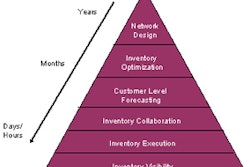December 22, 2006 — When considering the global trade environment in 2007 there are a number potential issues looming that can disrupt global supply chains, sourcing strategies and the flow of working capital. If not properly addressed, importers and exporters may face significant unexpected costs and increased disruptions to their supply chain. But the news for 2007 isn't all bad. A number of promising opportunities exist as well.
Risks
Risks
- 2007 Tariff Code Changes — Approximately every five years, the World Customs Organization updates the Harmonized Tariff System (HTS) nomenclature at the international (six-digit subheading) level to reflect changes in trade patterns and technology. Of the 97 HTS chapters, changes were made to 83. Accurate HTS code assignment is critical as it determines the manner in which a product is taxed when shipped across borders.
The problem: Very few international governments have published their country-specific changes, leaving businesses in the lurch and at risk of facing unknown duty increases, possible sanctions and delays in processing transactions as the industry scrambles to comply. The solution: Assign dedicated personnel or outside trade experts to monitor international government publications for timing and detail changes, and be prepared to make adjustments to your product classifications as soon as changes become available. - Reverse Logistics from Asia — We continue to see strong growth from manufacturers sourcing goods from the Asian marketplace. Businesses increasingly are looking for low cost country sourcing opportunities within and beyond China and India. As Vietnam and Thailand, for example, have potential to bring great cost benefits, a problem continues to cause concern — How will manufacturers effectively and efficiently manage reverse logistics from this region of the world? As more goods flow out of the region, what procedures, processes and infrastructure are in place to manage repairs, returns and warranties? On a country by country basis, businesses will succeed only if they can excel at managing a complex web of warehousing, distribution, personnel and government compliance issues.
- Global environmental regulations — Manufacturers of electrical and electronic equipment will continue to face additional environmental restrictions as 2007 progresses. Non-compliance with such directives can result in lost revenue, fines and damage to corporate reputation. Companies must be able to demonstrate compliance with these initiatives.
In 2006 we saw the European Union's Restriction of Hazardous Substances (RoHS) directive go into effect on July 1, with manufacturers restricted from using lead, mercury, cadmium, hexavalent chromium, polybrominated biphenyls and polybrominated diphenyl ether in their products. The Japan RoHS, a similar directive, went into effect in Japan in July as well. By year's end, the European Union's Waste Electrical and Electronic Equipment Directive (WEEE) will go into effect, setting collection, recycling and recovery targets for broken or unwanted electrical goods and "electronic waste" — components of such equipment that are considered toxic and are not biodegradable.
Pending restricted substances regulations include The Electronic Waste Recycling Act, California, United States (effective January 1, 2007); Article 11 (China RoHS), China (effective date: March 1, 2007); Registration, Evaluation and Authorization of Chemicals (REACH), European Union (effective date: spring 2007); The Act for Resource Recycling of Electrical/Electric Products and Automobiles (Korea RoHS), South Korea (effective date: July 1, 2007) and the Directive on the Eco-Design of Energy-Using Products (EUP), European Union (effective date: August 11, 2007). How do these impact your manufacturing operations? - Security — More than five years after 9/11, security continues to be a bigger concern for businesses in order to keep products running safely and smoothly through the global supply chain while complying with increasing government regulations and restrictions. The approach to a secure supply chain must be more multi-pronged than ever, starting at the top of the chain of command with C-level executives responsible for implementing and executing a sound compliance plan, down to desk-level operations where the expectation is to "know your customer."
At the most basic level, the responsibility is incumbent upon the person facilitating the shipment to know: Who is the shipper? Who is the consignee? What are the goods?
Government initiatives such as the Container Security Initiative (CSI) require that businesses have the ability to quickly integrate new requirements into their supply chain. Close communication across supply chain parties, including manufacturer, service providers and consignee, is imperative to get accurate information prepared in a timely manner. A missed sailing could result in missed sales or increased charges downstream to make a targeted delivery date. The challenge of security is a balance between keeping the borders safe from the minority who would do harm, while encouraging a smooth flow of commerce and travel for the rest of us. - Mandatory Automated Export System (AES) Filing — Though we expected this initiative to be finalized in 2006, it now looks like the mandatory filing of export shipment information will go into effect during the first quarter of 2007. The AES is an electronic, computerized system for tracking and controlling cargo export information and interfaces across many federal agencies. U.S. exporters must have effective compliance processes in place to address the new AES filing rules or risk facing significant civil and criminal penalties ranging from $1,000 per violation up to a maximum of $10,000. For additional information on AES filing, visit http://www.census.gov/foreign-trade/aes/index.html.
- Proliferation of bilateral and regional free trade agreements — The Doha Development Round of World Trade Organization negotiations aims to lower trade barriers around the world, permitting free trade between countries of varying prosperity. Talks have been hung up over a divide between the European Union and the United States and the major developing countries (represented by the G20 developing nations). As a result of this breakdown in talks, free trade agreements will continue to multiply.
Today, 10 regional free trade agreements are in existence, while nine newly proposed regional agreements are in various stages of agreement. Twenty-seven countries have bilateral agreements in place today, while more than 80 additional agreements are in various stages of negotiation. In September 2006, The European Union said it would seek bilateral trade deals with China and Korea, exploring new ways of conquering foreign markets as talks over a global trade pact flounder.
As free trade agreements proliferate, many companies are leaving millions of dollars worth of duty savings unclaimed. Don't be one of those companies. The complexity associated with understanding and leveraging free trade agreements is beyond the scope of many companies because their staff either lack the expertise, resources, technology or all of the above to do it efficiently and cost-effectively. Many companies eventually come to a decision point: either invest internally or outsource to a global trade expert. - On-shoring — Though the global sourcing boom has put Asia and Eastern Europe in the spotlight recently, manufacturers increasingly are looking at on-shoring opportunities closer to home in response to higher than anticipated total landed costs, quality issues, longer lead times, port congestion and higher fuel costs. There are also concerns over the potential impact if and when the Chinese RMB (yuan) floats on the open market. As a result, tried and true markets like Canada and Mexico are being revisited.
Companies must evaluate sourcing alternatives based on the strategic and financial value they bring to the overall business strategy. When making the decision to move or strengthen manufacturing operations, companies should consider conducting a strategic sourcing study. Strategic sourcing studies look beyond typical unit cost or landed cost comparisons. Analyzing the impacts of potential sources to working capital, time to market (profit) and risk of disruption due to political and economic risk, physical supply chain risk (weather, natural disasters, security and health epidemics) is critical to good decision-making. Creating different "what-if" scenarios that model real world variability enables a company to understand a range of potential costs versus a single "perfect world" estimate. - Radio frequency identification (RFID) — RFID is gaining ground in supply chain systems around the world, and adoption is just going to increase. Retail is one of the primary sectors, with the oft-quoted Wal-Mart mandate to its suppliers to adopt this technology, but other retailers around the world are also finding benefits from implementing RFID.
Industries adopting RFID run the gamut, from labeling cheese in Italy to livestock in Australia and just about everything in between. However, it is the increased adoption of RFID by logistics and service providers that provides benefits to all other verticals. A distribution center or cross-dock facility that has tested and proven efficiencies from this technology shares this improvement with any client's products received with compatible RFID tags — be they fine wines, auto parts or razor blades. Increased automation of pallet and container tracking results in efficiencies and cost savings, regardless of the product they transport.
Two major obstacles to widespread immediate adoption are cost and security. Calculating the hard cost of equipment and tags is much easier than calculating the economic benefits and assigning costs across the supply chain. Second is security. Concern about proprietary information, be it product related or personal, being intercepted cannot be discounted. The benefit of dialogue with opponents who resist RFID adoption out of privacy concerns is an increased level of awareness and improved solutions to address these concerns. Any conversation about RFID needs to include a plan to address security.












